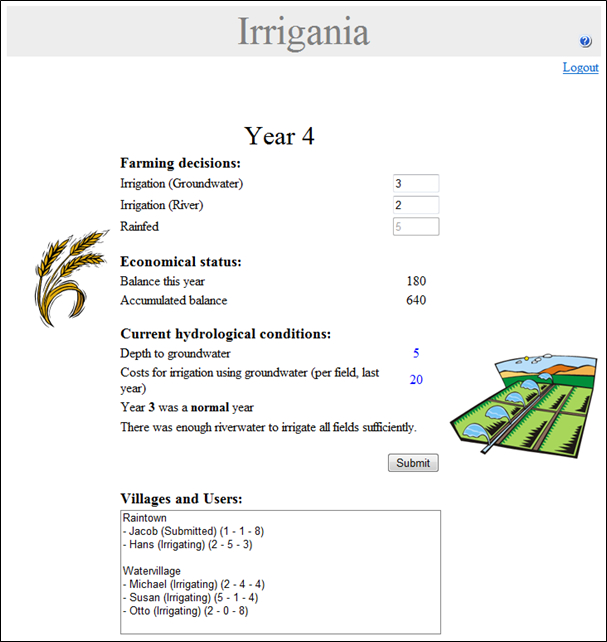In this month’s Geosciences Column, Wayne Deeker tells us about a new game – first presented in EGU’s Hydrology and Earth System Sciences – that aims to teach how to best share water resources.
With shrinking glaciers, depleted groundwater stores, and rising populations, water resources have never been under such pressure, and worse is yet to come. The resulting conflicts can get ugly and bring high stakes across borders. Resource management professionals, and especially today’s resource management students, are the ones who will bear the brunt of solving these problems. Any aid to make the teaching of water management easier is welcome.
Computer simulations have a long heritage in resource management teaching. Games, in particular, can effectively help students engage with, and understand, the issues. However, many previous water-management teaching games, which aimed to be as realistic as possible, were complex and difficult to understand. The ideal would be a game that simplifies reality yet also hits the key teaching points.
A hydrologist and a programmer from the University of Zurich, Jan Seibert and Marc Vis, have devised a solution. Their game, called Irrigania, is a web-based teaching resource that simulates irrigation conflict issues among farmers and villages. The researchers presented this new teaching tool in a paper published last month in Hydrology and Earth System Sciences, an Open Access journal of the European Geosciences Union.
Though Irrigania’s parameters are simplified compared to reality, they are well chosen and accurately modelled. Hence, the game authentically illustrates the issues typical in conflict situations in an understandable way.
Players take the role of farmers who aim to make the best profit. Each farmer must irrigate up to ten fields, and decide whether to use rain, river, or ground water. Each has different costs, revenues, and recharge parameters. For instance, use of river water leads to quick depletion, yet this source has no yearly memory; groundwater overuse will not be apparent for some time, but aquifers take several years to recharge. The winner is the player who can make the highest profit; to achieve it they must work cooperatively, as other farmers in the same village draw from common resources. The main teaching issue is achieving the collective optimum, and showing that this may be different from the preferred solution for any individual player.
Irrigania has two login modes, teacher and student. Teachers can obtain a teacher-login by registering with the authors; then teachers set up the game, specifying the game’s length, the number of villages and farmers, precipitation conditions, and whether farmers can see each other’s input values. Players obtain their login details from the teacher and make decisions on how to use their fields. When all players have entered their values, the server runs the calculations and the game steps forward one year. During the game, farmers can see their accumulated balance, current hydrological conditions, and the previous year’s input of other farmers. At the end, farmers can go to the results page, tabulating outcomes per farmer and per village.
The authors recommend running game sessions in a computer laboratory where a class of students can communicate. They also suggest playing several rounds, exploring the game’s settings and possibilities. Irrigania can be played with any number of players, but four to six per village yields the most interesting outcomes and discussions.
Specifically, the authors noted that farmers in cooperative villages did best on average, though selfish farmers could still win. In such cases, the other players punished the selfish player by overusing their own resources, decreasing the whole village’s income. While not strictly rational behaviour according to conventional game theory, this realism is one of the game’s strengths. Hence, when players play several rounds, the folly of selfish behaviour becomes more apparent, making the tactic less attractive next time. Furthermore, when students did not know who the other farmers were, the lack of social control led to greater overuse and less income on average. Thus greater overuse should occur when players can make their decisions in secret. Cooperation also makes students more aware of the importance of keeping groundwater stable. Finally, the game illustrates the increasing difficulty of decision-making given unpredictable rainfall. When the game is set to random rainfall, players operate with partial information and, just as in real life, this makes long-term decisions more difficult.
As a tool for teaching water management issues, especially the classic Tragedy of the Commons, Irrigania should benefit teachers and students alike.
By Wayne Deeker, freelance science writer

